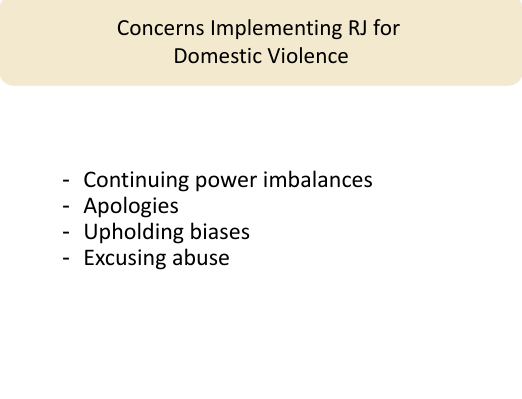Everyone Makes Mistakes
Everyone makes mistakes and deserves the chance to make amends and progress. In contrast to deterrence, restorative justice centers around meaningful transformation rooted in natural consequences and learning from one's experiences.
Uniting individuals to acknowledge the harm inflicted and the resulting impacts, we alleviate suffering for the sake of suffering. The emphasis is placed on building skills, community, and addressing individual needs of those involved. With this, we diminish the likelihood of recurring harm, and contribute to a reduction in crime rates. By fostering growth and understanding, steering away from punitive measures, we foster an environment that encourages positive change.
In terms of domestic conflict, this means victims are encouraged to engage to the best of their abilities and can guide follow up expectations and meet everyone’s needs.
IN THIS LESSON
Restorative Justice is a diverse array of practices that facilitate reflective discussions that respond to crime with a non-adversarial and non-retributive approach. The core objectives are to cater to the individual needs of participants, placing emphasis on healing, fostering accountability from the person who has caused harm, and developing a comprehensive restitution plan.
Grounded in trauma-informed practices, we cultivate understanding and empathy among all involved parties, aiming to reduce the likelihood of recidivism and promote transformation.
Some distinctive features of Restorative Justice are its flexibility in facilitation strategies, empowering victims to take a leading role in shaping the narrative, and influencing the type of justice that aligns with their needs.
By adjusting our approach to helping those impacts by harm, we are able to adapt to the multifaceted challenges and multiple methods in which domestic conflict is employed, and allowing for those harmed to access the justice that is meaningful to them.
Best practices of Restorative Justice require the following foundational principles to be upheld:
Participation is voluntary
Those harmed and those causing harm are the center of the discussions
Understanding is vital for an effective outcome
The person causing harm must take accountability for healing
Safety, physical and emotional, are critical
The effectiveness of Restorative Justice relies on prioritizing trauma-informed client-centered approaches, fostering common ground for establishing next steps forward.
Our current justice system requires investigations of alleged behaviours, seeking evidence beyond a reasonable doubt, and providing evidence that may not exist. This requires that those who have been harmed and witnesses to the harm have the courage to speak with police about their most traumatic moments, and repeatedly tell their story throughout the process of the courts. These are complicated by memory impacted by trauma and toxic stress, where recalling specifics may be difficult or seem inconsistent.
Obstacles to accessing the justice system includes requiring time off work to attend court, expensive lawyers to oversee complicated adversarial procedings, removing control from those who have been harmed and revictimizing them from the power imbalances of the relationship, and having to repeatedly tell their story as they are interrogated for inconsistency or misstep.
All of these obstacles for a judicial finding which does not address the cause of the harm, does not address the needs of the person who was harmed in order to heal, places further financial strain on all parties, and removing people from their communities if they are placed in custody or forced to leave their home. These increase the risk of police involvement and further criminal behaviours.
The concerns of using Restorative Justice with domestic conflict cannot be taken lightly. The most commonly cited concerns of using Restorative Justice include:
Allowing continued power imbalances between the person harmed and the person causing harm;
Focus on apology as restitution which is often part of the cycle of violence which have been likely used numerous times despite not following through on the meaningful action to change;
Mediators upholding biases/gendered norms;
Concerns the mediator would excuse the abusive behaviours instead of understanding the experiences that brought someone to causing harm.
In the same vein, the criminal justice system have numerous power imbalances - what is the difference between these power imbalances held over families where professionals hold all control and they cannot take individualized approaches?



